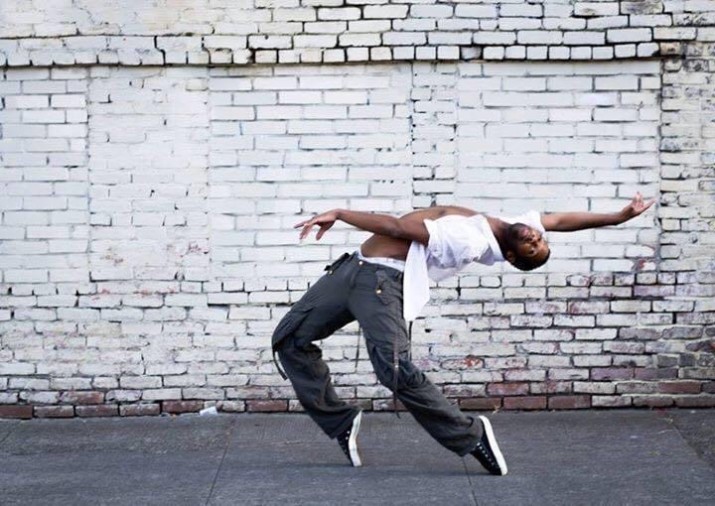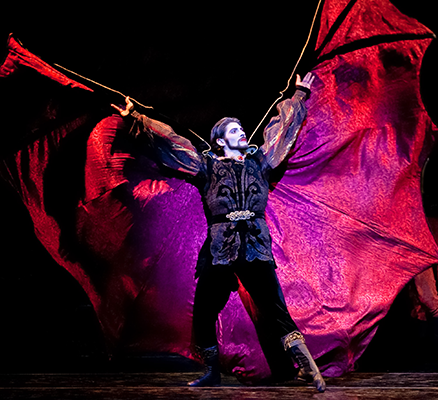Portland, OR. The NW Dance Project, a Portland-based contemporary dance company, had to make significant COVID-19 adjustments since it went fully virtual on March 13th. The nonprofit’s phased reopening began on August 3rd, with the renewal of some in-person classes and continued reliance on video communication platforms. Jeff George (pictured above) is one of the instructors for the limited in-person classes that take place with strict safety protocols.
The initial shutdown of NW Dance Project meant all events, classes, and training programs were canceled, as well as the furloughing of all company dancers and some staff. Like many arts organizations, NW Dance Project is currently unable to generate income with performances, so outreach to supporters has become vital.

NW Dance Project members pose for a fundraising promo shot
Social distancing guidelines have posed a challenge for everyone, but perhaps no one is more affected than dancers. Executive Director Scott Lewis points out how, unlike other performing arts such as theater or music, maintaining social distance removes a core element of what constitutes this art form. For example, the pas de deux, which Lewis describes as an intense duet, is now entirely off the table.
“There’s so much in dance that relies on the electricity in the air when humans are experiencing something simultaneously,” says Lewis. “At some point, it just hit me that everything we do is not bringing people together.”
NW Dance Project – Social disDANCING from NW Dance Project on Vimeo (seen below) is a playful approach to the COVID shutdown from NWDP dancers.
NW Dance Project – Social disDANCING from NW Dance Project on Vimeo.
The dancers’ response to these challenges highlights their pragmatism and flexibility. “They quickly saw the dance world embracing technology and accepted that this is the reality,” Scott Lewis explains. Company members have shifted their focus toward individual projects and sharing their skills over social media. In addition to individual enterprises, dancers now attend classes via video call — streamed either from NWDP’s studio or from the instructors’ homes — and students served by North Portland’s Aspire Project (closed as of June 7th, 2020) were invited to join NWDP’s virtual summer session.
These virtual classes will continue even as NWDP’s studios have reopened for limited in-person classes. Safety protocols are strictly enforced: for example, tape outlines on the studio floor mark out 100 square feet of space per person. In September, youth classes are scheduled to begin in-person with similar restrictions. Next month also brings an outdoor performance and a film-based project that unites NW Dance Project company dancers and special guest choreographers.
Lewis encourages readers to keep an eye on these upcoming projects or even attend a few classes if they are so inclined. Those with skills they are willing to share can seek out volunteer opportunities with the company or even serve as board members if they are willing to accept the time commitment.
“Any support possible will be helpful,” says Lewis. “It doesn’t need to be said how destabilizing the confluence of events has been for artists. We’re still in the first act, stay with us, stay in touch, stay supportive. This is going to be a long crawl.”
From NW Dance Project’s website:
NW Dance Project was founded in Portland in 2004 by acclaimed dancer, mentor, and choreographer Sarah Slipper. NW Dance Project is dedicated to the creation and performance of innovative, new contemporary dance works from established and emerging dance makers created in an open and artistically stimulating environment.
NW Dance Project has fostered the creation and Portland premiere of nearly 300 original contemporary dance works to date. Our dedication to providing dancers and dance-makers the resources and creative room needed to realize new inspired dance works led Dance International Magazine to proclaim that we are “changing the way dance is created” and that NW Dance Project has become “a laboratory, factory, and repository for risk-taking new works from the next generation of choreographers from Europe and North America.”
















